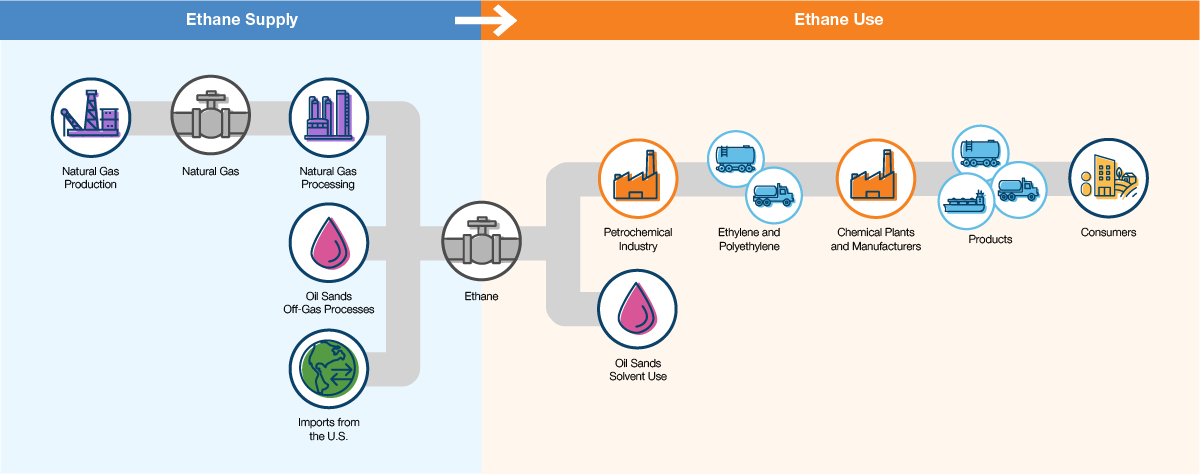Market Snapshot: Petrochemical growth in Alberta can bring significant changes to western Canada’s ethane market
Connect/Contact Us
Please send comments, questions, or suggestions for Market Snapshot topics to snapshots@cer-rec.gc.ca
Release date: 2024-10-30
From ethane to plastic products
Raw natural gas production includes methane, impurities, and various amounts of natural gas liquidsFootnote 1 including ethane, which can vary depending on the geography and chemical compositions of gas reservoirs. Some of the ethane in natural gas is extracted at large gas-processing facilities located on major natural gas pipelines in Alberta and B.C.Footnote 2 A small amount of ethane is also produced from oil sands off-gas processes. Alberta’s supply of ethane comes from domestic production as well as importsFootnote 3 of ethane from the U.S.
Once produced, ethane is transported in liquid form to petrochemical facilities via pipeline. These facilities turn the ethane into ethylene, polyethylene, and other derivatives, via processes such as cracking. These intermediate products are then transported to various chemical plants and manufacturers in Canada or internationally via truck, rail, or marine vessels, and are used to make numerous consumer products such as bottles, paint, clothing, antifreeze, and detergents (Figure 1).
Figure 1: Ethane lifecycle process

Source and Description
Source: CER
Description: This figure illustrates the ethane lifecycle process from supply sources to consumers.
Ethane supply: Natural gas production, natural gas, natural gas processing, oil sands off-gas processes, and imports from the U.S.
Ethane use: Petrochemical industry, oil sands solvent use, ethylene and polyethylene, chemical plants and manufacturers, products, and consumers.
Ethane exports?
Ethane in natural gas is either extracted at processing facilities or remains intrinsically in the natural gas stream. Ethane that is extracted is used in Canada in the petrochemical industry, as Canada does not export ethane as a sole product on an export pipeline. Ethane remaining as part of the natural gas is either used by domestic natural gas consumers or exported via pipeline to the U.S. or as LNG. The Alliance pipeline, for example, is unique among major Canadian natural gas pipelines because it can transport natural gas with higher levels of ethane and other natural gas liquids (NGLs).Footnote 4
A new petrochemical facility in Alberta
On 29 November 2023 Dow Canada reached a positive final investment decision on its Path2Zero project—a net-zero emissions, integrated ethylene cracker and derivatives facilityFootnote 5 in Fort Saskatchewan, Alberta. Path2Zero will increase Dow’s polyethylene and ethylene derivatives production capacity by about 3 million metric tonnes per year, helping supply growing global demand for plastics, including polyethylene.Footnote 6 Construction for this projectFootnote 7 is currently underwayFootnote 8, with constructionFootnote 9 expected to be completed in 2029.Footnote 10
Ethane dispositionFootnote 11 and supply in Canada
Ethane is used primarily in the petrochemical industry and very minimally in oil sands projects.Footnote 12 The Path2ZeroFootnote 13 petrochemical facility will require significant ethane feedstock – an estimated 120,000 barrels a day – which will significantly increase Canada’s ethane consumption (Figure 2). The CER’s Canada’s Energy Future 2023 (EF2023) report assumes Path2Zero would go ahead as planned in all its scenarios, including both net-zero scenarios.Footnote 14 In all scenarios, total ethane demand grows with construction of this facility and remains stable thereafter.
Canada’s ethane supply is from domestic production and pipeline imports from the U.S . Historically, in general the amount of ethane that is extracted from natural gas in western CanadaFootnote 15 equals what is needed to meet disposition after factoring in imports and minimal industrial production.
Figure 2: Ethane disposition and supply balance for EF2023 scenarios: Current Measures, Canada Net-Zero, and Global Net-Zero
Source and Description
Source: Canada’s Energy Future 2023: Energy Supply and Demand Projections to 2050 – Data Supplement
Description: These charts include historical and projected annual values for ethane disposition and supply from 2010 to 2050 for three scenarios (Current Measures, Canada Net Zero, and Global Net Zero). Historical disposition grew from 210 thousand b/d in 2010 to about 350 thousand b/d by 2023. Disposition is projected to grow to about 475 thousand b/d with the demand from the Path2Zero project.
Production of liquids-rich tight natural gas has increased in western Canada in recent years, particularly from the Montney Formation.Footnote 16 This has led to a significant increase in the availability of ethane. Demand for ethane has not increased along with it however, and increasing amounts of ethane are being left in the natural gas stream. This is shown by the grey wedges in Figure 2’s supply charts. Over the projection period natural gas production levels vary greatly between the three scenarios, which also means the amount of ethane available for extraction from natural gas varies greatly. The lower levels of natural gas production in the net-zero scenarios means not enough domestically sourced ethane is available to meet remaining demand.Footnote 17 In these scenarios, increased imports into western Canada from the U.S. are needed to meet demand from the petrochemical industry in western Canada (the light purple wedges in Figure 2’s supply charts).
- Date modified:
